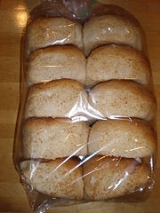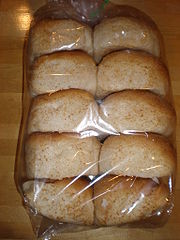Pan de sal is a rounded
breadBread is a staple food prepared by cooking a dough of flour and water and often additional ingredients. Doughs are usually baked, but in some cuisines breads are steamed , fried , or baked on an unoiled frying pan . It may be leavened or unleavened...
made of flour, eggs, yeast, sugar, and salt. It has become a common food in the Philippines.
Description
Pan de sal is the most popular yeast-raised bread in the Philippines. Individual loaves are shaped like garrison caps due to its unique method of forming. The dough is rolled into long logs (baston) that are rolled in fine bread crumbs before being cut into individual portions with a dull dough cutter and then allowed to rise and baked on sheet pans. Its taste and texture closely resemble those of the
Puerto RicanPuerto Rico , officially the Commonwealth of Puerto Rico , is an unincorporated territory of the United States, located in the northeastern Caribbean, east of the Dominican Republic and west of both the United States Virgin Islands and the British Virgin Islands.Puerto Rico comprises an...
bread called Pan de Agua and
MexicanThe United Mexican States , commonly known as Mexico , is a federal constitutional republic in North America. It is bordered on the north by the United States; on the south and west by the Pacific Ocean; on the southeast by Guatemala, Belize, and the Caribbean Sea; and on the east by the Gulf of...
Bolillos. These breads all use a lean type of dough and follow similar techniques that were learned from Spanish or Spanish-trained bakers early in their history. As in most commercially produced food items, they vary in quality to meet taste requirements and economic standards of various communities.
History
Despite the Spanish origins of its name, pan de sal was introduced in the Philippines in the 16th century. Pandesal originally started out as a plain roll, traditionally served for breakfast accompanied by such items as butter, cheese, scrambled eggs or filled omelets, sausages, bacon, Spanish sardines, jams, jellies and marmalade, coffee, tea or hot chocolate. Originally, pandesal was similar to the French baguette, as the only ingredients needed were hard wheat flour, water, yeast and salt. Over the years, since the quality of wheat flour available could no longer result in the ideal crusty exterior and chewy interior, pan de sal gradually evolved into a sweeter and richer type of bread. The common quality though that the old style lean pan de sal shares with the modern sweeter version is its coating of bread crumbs, giving its identifying flavor. Pan de sal can be made from any type of dough and still resemble pan de sal as long as the unbaked dough is rolled in fine breadcrumbs before baking. The softness of the new type of pan de sal, that consumers unaware of the correct texture now find desirable, is due to its weak dough structure derived from inferior quality of flour used.
Yellow pan de sal
To mitigate the potential impact of white flour's increasing costs in 2008, the Food and Nutrition Research Institute (FNRI) of the Philippines presented an alternative dubbed the "yellow pan de sal." Although tradition dictates that pandesal make use of white flour, the recipe substitutes about a third of the white flour with squash puree. The FNRI endorsed the yellow pan de sal's nutritional value and potential remedy to the rising cost of flour imports. Despite the FNRI's endorsement through a pilot program in Zambales, the yellow pandesal failed to capture the attention of the market.
The source of this article is
wikipedia, the free encyclopedia. The text of this article is licensed under the
GFDL.



